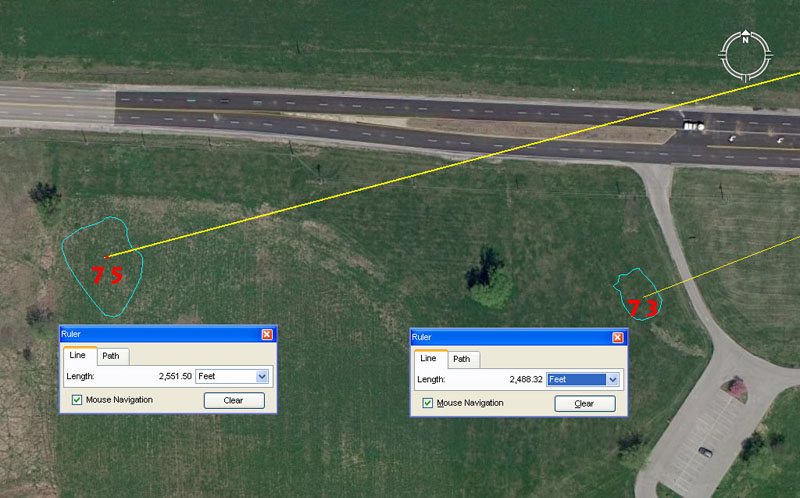
We now come to an area of the site where the ancient architects placed the mounds so that the distance out from the hub atop Monk's Mound was a direct reflection of the angle out from the hub. This kind of coding is reasonably rare at ancient British open-air-universities, but occurs at the Cahokia site within a grouping of 4 close proximity mounds.
Mound 73 sits a coded distance of 2488.32' from the hub position on Monk's Mound @ an intended azimuth angle of 248.832-degrees.
This mirroring of distance and angle is in homage to the 24883.2 mile equatorial circumference, which is 12 X 12 X 12 X 12 X 1.2 miles.
Mound 75 sits a coded distance of 2551.5' out from the hub atop Monk's Mound @ 255.15-degrees.
This mirroring of distance and angle accentuates the 2551.5-day period (7.2 lunar years of 354.375-days each) monitored alongside 2556.75-days (7 solar years of 365.25-days) in the ancient lunisolar Sabbatical calendar.
Ancient astronomers needed a calendar system that followed the periods of the Sun & Moon on a daily basis, but there was a major problem to overcome. With the solar year @ 365.25-days and the lunar year @ 354.375-days, the discrepancy was almost 11-days. Trying to create a mathematical system that could fluidly and easily accommodate both cyclic periods posed considerable difficulty. It was observed, however, that 7 solar years was almost the same as 7.2 lunar years. The difference was only 5.25-days, so ancient mathematicians then devised measurement increments based upon 5.25 to deal with this. They created a reed of 10.5' (2 X 5.25'), a short stadia of 525' and a mile of 5250'.
Under their system the solar and lunar periods could then be counted off in increments of 5.25-days. The sum of 486 X 5.25-days was 7.2 lunar years or 2551.5-days, whereas 487 X 5.25-days was 2556.75-days or 7 solar years. The astronomer-mathematicians then devised a system wherein, on the sixth day (5.25-days is into the sixth day) after starting the solar count, they would have an auspicious ceremony and start the lunar count (culling sprigs of mistletoe from a venerable old oak tree, while other savant-astronomers danced around the tree singling "Hey Derry-Derry Down", etc.). Thus by starting the lunar count 5.25-days after the solar count the periods for both Sun & Moon ended on the same day 2551.5-days later. This was the very successful and accurate Sabbatical Calendar system.
We see here at mound 75 site just how important the value 2551.5 was to ancient astronomers, who double-coded it into a dedicated site so that the value could never be forgotten.
Mound 74 has already been dealt with in the grouping of mounds 56 to 59. It sits beside mound 58 and the same kind of dual coding of distance and angle occurs, with mound 74 sitting at 2400' from the Monk's mound hub @ 240-degrees azimuth and mound 58 sitting out 2376' @ 237.6-degrees.
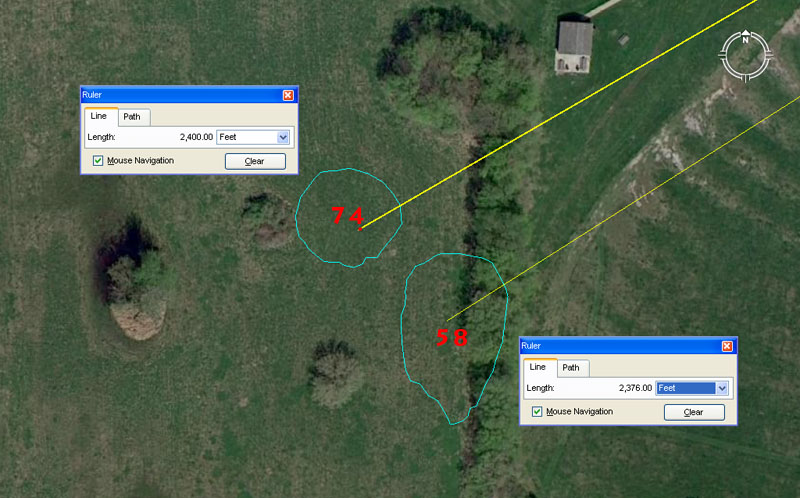
The UWM map places mounds 74 & 58 at exactly these locations above and notes on the map the tufts of trees or bush situated to their west.
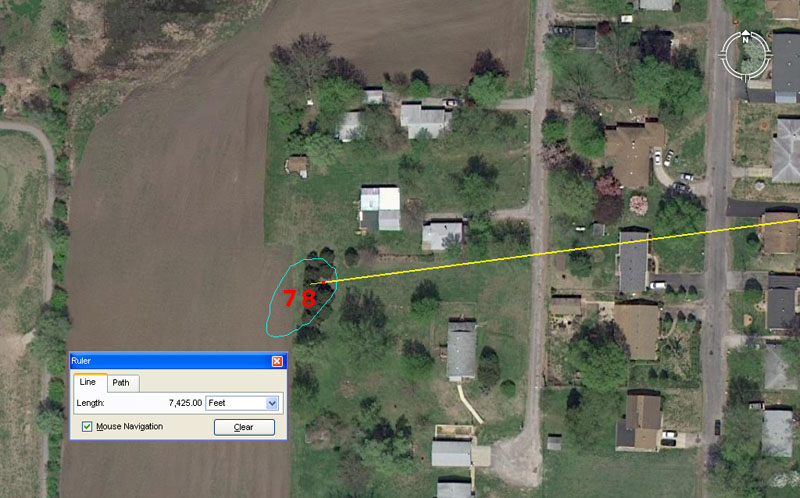
Mound 78 sits 7425' from the hub position atop Monk's Mound at an azimuth angle of 262.5-degrees, for a return angle of 82.5-degrees.
Mound 78 is situated just a bit too far away from other mounds to be included within a group. The nearest cluster, mounds 84, 86, 87 & 88 were long-since destroyed and their locations obliterated, with the former positions sitting under the tar-seal of a car parking lot. Mound 78 has been ploughed down to virtually nothing, but some evidence remains. It sits 1.25 Scottish miles from the hub position atop Monk's Mound.
The outwards running angle from Monk's Mound is strong lunar and navigational coding simultaneously. A Greek mile @ 5250' is 2 X 2625'. There would be 135 intervals of 2.625-days (63 hours) in a lunar year of 354.375-days or 972 in the 2551.5-days monitored within the ancient calendar. There would be 2592 (36 X 72) such occurrences in the 6804-day lunar nutation cycle.
The inwards running angle relates to the "11" navigational system and 8250' is half an ancient English league of 16500'. Alternatively, 8250-miles is 1/3rd of the 24750-mile equatorial circumference.
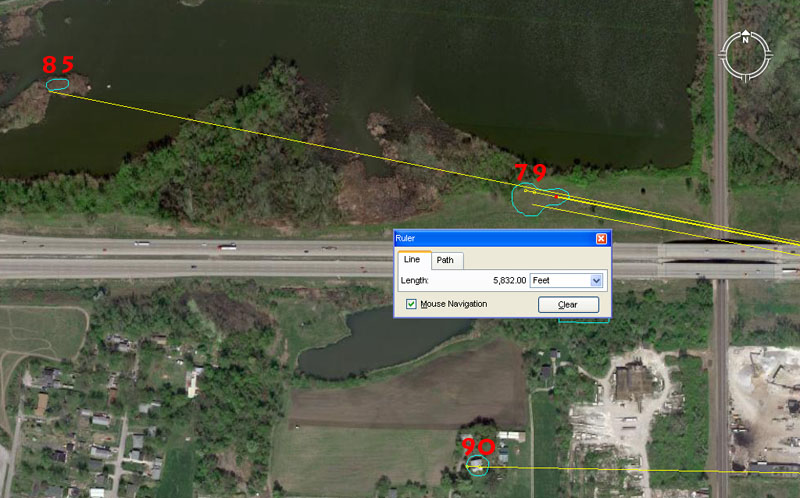
Mound 79 sits in reasonably close proximity to mounds 46 (covered by the Google Earth measurement panel), 85 & 90.
Mound 79 carries at least 3 length codes and 3 angle codes. The first of these is 5832' out from Monk's Mound hub @ 281.25-degrees, for a return angle of 101.25-degrees.
The distance of 5832' is 1200 Roman paces or 6000 Roman feet of 11.664" each. These so-called Roman measurements recur all over Britain on sites that predate the Romans by 2500-years and more. This same distance would equate to 1.2 Roman miles of 4860' each (5000 Roman feet). The outrunning angle of 281.25-degrees is lunar and navigational coding and a mathematical progression based on this value will generate useful increments for compass calculations of lunar cycle determinations. The sum of 2.8125-degrees (213/16ths) would be 1/128th of 360-degrees ... or 1/8th of 22.5-degrees. There would be 126 intervals of 2.8125-days (67.5-hours) in the 354.375-day lunar year. Note: Big Mound in old St. Louis Missouri sits exactly 6.75-miles from the hub atop Monk's Mound (@ 260-degrees azimuth) and Sugarloaf Mound in Old St. Louis sits 28125' from Big Mound (@ 207.36-degrees).
The return angle from mound 79 to Monk's Mound, in this instance, is 101.25-degrees and this is very strong lunar coding. There would be 35 intervals of 10.125-days (243-hours) in a lunar year of 354.375-days.
A second length coding onto mound 79 would be a distance of 5906.25', which is also strong lunar coding. In the 3,4,5, triangle formula by which the Khafre Pyramid of Egypt was built, the hypotenuse length was 590.625'. The sum of 590.625-days would equate to 20 lunar months of 29.53125-days each (2917/32nds).
A third length coding would be 5940' or 1 Scottish mile.
Another return degree angle from this mound's centre is 100.8-degrees and the sum of 100.8' was 1-second of arc under the 24883.2 Greek mile equatorial circumference of the Earth.
Mound 85 was once described as extensive, but is now much diminished in size. It sits a coded distance of 7776' out, with an apparent return angle of 101.376-degrees. Both distance and angle are navigational coding.
The sum of 777.6-miles is 1/32nd of the 24883.2-mile equatorial circumference.
Under the "true" equatorial size of the Earth, described in factorable numbers as 24883.2-miles of 5280' each (18.8-miles short of the true figure we use today), 1-second of arc was 101.376'. Francis Cranmer Penrose, in 1846, carefully measured the shorter length of top stylobate step of the Greek Parthenon of Athens 101.335 feet, but did not take into account 2500-years or weathering, which would have made it somewhat longer.
Return angles from these mounds seem to be coding 1-second of arc under 3 systems, including 100.833333 (based upon the 24750-mile navigational system).
Mound 90 sits 6000' from the hub atop Monk's Mound @ a return angle of 91.125-degrees. The western edge of mound 90 sits 6048' (1-minute of arc) from the Monk's Mound hub.
The 91.125-degree return angle is primarily lunar coding. There would be 28 intervals of 91.125-days (911/8th) in the 2551.5-day (7.2 lunar years) monitored within the ancient lunisolar calendar.
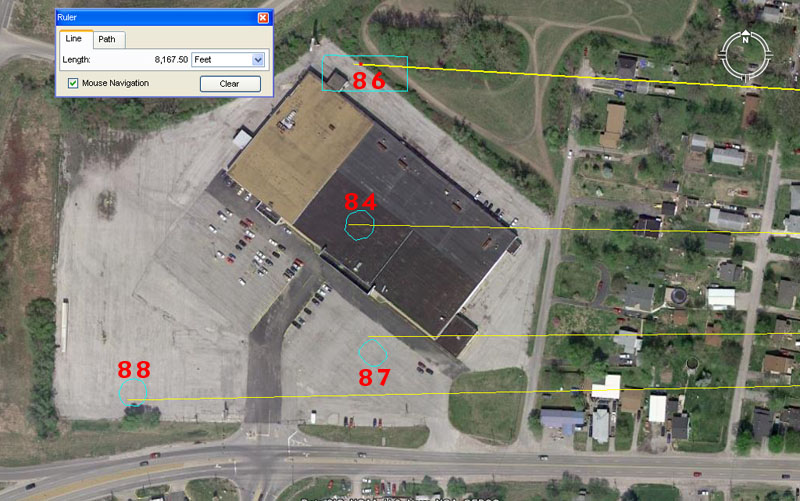
These 4 mounds, 84, 86, 87 & 88 have been hammered as bad or worse than any other grouping and entirely eradicated. The UWM map places them at the locations shown, so we'll try to make sense of what their intended codes of position were originally meant to be.
Mound 84 sits 8164.8' from the hub position atop Monk's Mound at a return azimuth angle of 91.125-degrees. This same vector crosses mound 90 in its more extended journey to mound 84.
The 8164.8' distance is coding the division of the 24883.2 Greek mile equatorial circumference into sixteenth parts and the sum of 8164800' (1555.2 Greek miles) would be 22.5-degrees of arc for that circuit.
Mound 86 sits 8167.5' from the Monk's Mound hub @ a return angle of 93.312-degrees.
The 8167.5' distance is coding the division of the 24750-mile (of 5280') equatorial circumference into sixteenth parts and the sum of 8167500' would be 22.5-degrees of arc for that circuit.
The degree angle @ 93.312-degrees is also navigational coding and divides the 24883.2 Greek mile equatorial circumference into fourteenth parts. The sum of 9331200' would be 1/14th of the circuit. Note: Under the Babylonian-Sumerian weights system the Royal Double Standard Talent was 933120-grains. Their Royal Double Standard Mina was 15552-grains (the sum of 1555.2 miles is 1/16th of the 24883.2 mile circumference)and their Shekel was 259.2-grains (the Precession of the Equinoxes endures for 25920-years).
Mound 87 seems to be coded in a "13" progression that might have had some application to the 13, 26, 52 counts within the calendar. It appears to be situated out 8125' at a return azimuth angle of 89.6-degrees and 1/75th of an ancient Irish mile was 89.6'.
Mound 88 was probably intended to sit 8640' (a much used, dynamic ancient value) from the hub atop Monk's Mound, but its marked position falls short of that by about 30'. The azimuth angle to the mound (268.8-degrees .. a much-used navigational value) works well in dividing up the Earth into Roman miles of 4860' each. Therefore the 24883.2 Greek mile equatorial circumference in feet (130636800') ÷ 26880 = 4860'.
We'll now move to other mounds that have fared considerably better than this batch in West Collinsville.
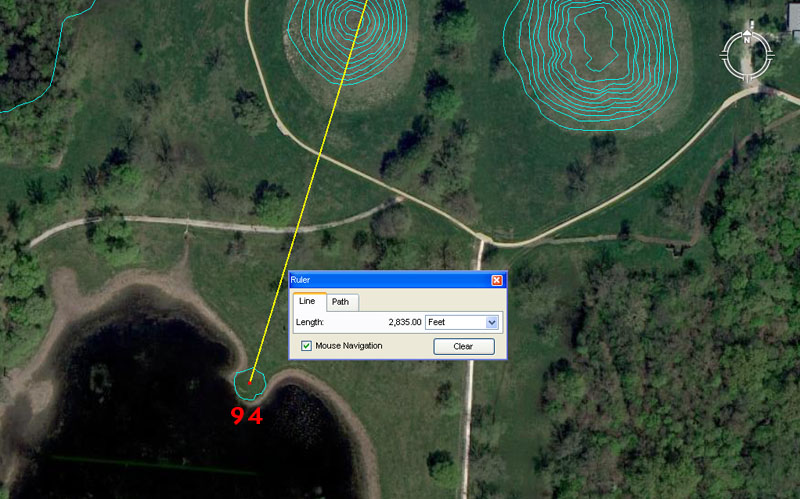
Tiny mound 94, situated south of mounds 59 & 60, contains dynamic lunar coding in both its distance and angle.
Mound 94 sits 2835' from the hub on Monk's Mound at a return angle of 17.01-degrees.
The Khafre Pyramid (Egypt's pyramid of the Moon) @ 708.75' per side (2 X 354.375 or, in days, the length of a lunar year) had a full perimeter value of 2835'. This distance at Cahokia Mounds is, therefore, a duplication of one circuit of the Khafre Pyramid. It is also the internal length of the Octagon geometric earthworks complex of Newark, Ohio (from the altar alcove SW to the outer line of the NE gate).
The return angle was intended to code 17.01-degrees in homage to the duration of the 6804-day lunar nutation cycle, the quarter period of which is 1701-days. The half value of that cycle is 3402-days and the 2835' length out to mound 94 is 34020-inches.